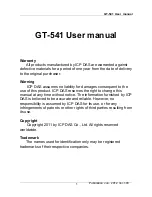
TD 92326GB
2009-03-10 / Ver. E
Installation and Operation Manual
VoIP Gateway
170
Appendix D: Call Routing depending on Device Management
In principle, calls to and from differently configured VoIP devices are handled in a similar
way by the VoIP Gateway. There are some differences in detail, which are outlined in the
following sections.
D.1
Calls to and from gateway groups
In principle, routes to such groups are configured in the same way as normal routes. The
dial prefix defined for the route is regarded as matching the called number if the number
matches the dial prefix completely and all of the missing digits required to complete the IP
address of the destination device have been dialled. Superfluous digits subsequently
dialled are passed on to the destination device, if appropriate.
Digits required to complete the address
3, 6, 9 or 12 digits are required to complete the IP address. This depends on the size of the
host share in accordance with the subnet mask specified in the
Gateway
definition. The
individual digits are converted to bytes of the address in groups of three digits.
The table above shows the number of digits required. Complete bytes of the address have
to be dialled in groups of three, even if less than 8 bits are required, according to the
subnet mask configured. Leading zeroes must also be dialled.
Assuming there is a group of VoIP devices defined by the network address
195.226.104.128 and the subnet mask is 255.255.255.128. The addresses
195.226.104.129 to 195.226.104.254 are thus accessible. The dial prefix for the route to
this group has been configured with 91. To call the device with the address
195.226.104.135, the number 91135 has to be dialled.
If “Automatic correction of all calling numbers” (see section
on page 146) is activated and a call arrives from a device defined in a
group of VoIP devices, the digits required to complete the IP address of the calling device
are placed in front of the calling number. As a result, callback is possible via the supplied
number.
D.2
Calls to and from devices managed by RAS
Calls can be routed to a device registered with the gatekeeper by means of the RAS
protocol using the call number or name. Here, calls to gateways are treated somewhat
differently than calls to terminals.
In principle, calls are switched to a VoIP device managed by means of the RAS protocol in
a normal manner (refer to section
Considerations on the Configuration of Call Routing
If a “Map” entry of a route is found which matches the called number and if this entry or
the route has a “VoIP Interfaces” definition as destination which is configured as
“Gatekeeper client group”, all aliases are searched through in this gateway for an entry
Size of the host share in bits Number of digits
Example
1 to 8
3
Class C address
9 to 16
6
Class B address
17 to 24
9
Class A address
More than 24
12
Unspecified group (0.0.0.0)





































